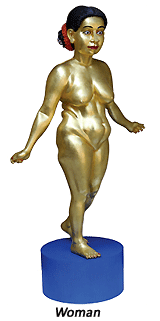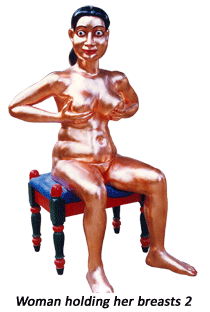- Prelude
- Editorial
- 'Public Sculptures are the Public's own Consciousness'
- Stimulating Thoughts
- Sculptural Traditions and Contemporary Art Practices
- Sculpting out a Third Dimension from Madhya Pradesh
- About Nostalgic Dragonflies and Homes in the Bags: Sculptural Snapshots from the North-East
- A Concise Chronicle of Bengal's Modern Sculpture
- Neo-sculptural Identity: Six Young Sculptors
- From Object to Experience: Notes on American Sculpture
- In the Domain of Drama Sculptures of S.Nandagopal
- Satish Gujral : Sculpting the Inner Form
- Transformation of Articulations: Mrinalini Mukherjee
- The Experiential Quotient in the Sculptures of Ravinder Reddy
- Shresta Rit Premnath A Passion for Structure
- The Anatomy of Melancholy: Sculptures of Rajesh P Subramanium
- A Crusader of/for Site Specific Public Art: Subodh Kerkar
- Installation Practices in and around Santiniketan
- A Wall is a Screen: A Promenade Film Street Performance
- Jaeger-LeCoultre An Overview
- Regency Style: Regency Furniture
- Designing the Streetscapes: Visual Elements of Pedestrian Corridors
- Sculpture Rules It All
- The Triumph of the Eternal
- Artist Index and Statistics- Anish Kapoor
- Auction Reports
- Musings from Chennai
- Art Bengaluru
- Art Events Kolkata: October-November 2010
- Mumbai Art Sighting
- An Evening of Interaction
- 6th Asian Museum Curators' Conference
- Swedish Art in India
- Couple of Difference : Recent sculptures of Karl Antao
- Previews
- In the News
- Sotheby's : Important Watches Geneva
ART news & views
The Experiential Quotient in the Sculptures of Ravinder Reddy
Volume: 3 Issue No: 11 Month: 12 Year: 2010
by Koeli Mukherjee Ghose
Ravinder Reddy, born in 1956, in Suryapet of Andhra Pradesh, lives and works in Visakhapatnam.
 The full-bodied, monumental sculptures in fiber glass, of wide-eyed women that he creates, spawn a sense of bewilderment in the viewers. This expression of bewilderment casts a field of magnetism around the sculpture and the onlooker that is difficult to disengage from.
The full-bodied, monumental sculptures in fiber glass, of wide-eyed women that he creates, spawn a sense of bewilderment in the viewers. This expression of bewilderment casts a field of magnetism around the sculpture and the onlooker that is difficult to disengage from.
The entire form when viewed in the round, is difficult to grasp in its totality. Physical distance and increased frequency make the total from graspable visually. The conceptual forms, their colour and making, in their apparent simplicity of presenting frontal standing and seating, nudes and embellished personas, flaunting the power to captivate the onlooker, raise questions that are not satisfied with easy answers of pushing the impending form of discussion under genre charts of Pop and Kitsch. Understanding that the pop art is aimed at employing images of popular as opposed to exalted cultures in its emphasis on the banal or kitschy elements of a culture, mostly expressed through irony, the pop and the Kitsch plays only a part in the making of these experiential forms.
Consciousness plays a twofold and distinct function in cognition. All cognitive experience is an active process that lends an objective or a determined form to knowledge. The mind does not engage in an awe-inspiring relation with any superfluous object which it studies without interest. “It is the cognition that leads to recognition” Harsha V. Dehejia,  (Aesthetic Implications of Divine Consortship), that the object of cognition eventually leads to the recognition of the subjective or personal.
(Aesthetic Implications of Divine Consortship), that the object of cognition eventually leads to the recognition of the subjective or personal.
The experience that looms large is not that of the familiarity of the feminine forms of the sculptures but the conflict the presence brings up, whether to perceive the created persona as the consort, an object of desire or divinity. The position is somewhat analogous to the relationship of adoration and passion of the artist, while in the process of creating, and the viewer, as he or she is contemplating the sculpture with some doubt as well as desire. This in turn imbues the sculptures with a sense of consortship of the beholder.
The wide-eyed feminine forms manifest a sensibility of adoration of the alluring form that wields the power to gaze back at the beholder of her charm, in complete blatancy. In history the creation of the feminine, be it the Yakshi, Mother Goddess, Parvati and Lakshmi, has forever been the reflection of the inspired vision informed with feminine sensuality and its strength. The form when attributed with iconographic signification, informs it with specific notions, of properties, significance and mythological narration.
Ravinder Reddy's powerful embodiments of feminine presence reinforce their sexual selves, exude desire and bring up the notion of desire and its ethics to discussion, the viewer is steeped in perplexity in the process of controlling his or her own aspirations to respond to the monumental signification of desire.  The shape of the breasts and suggestive folds and flab, the visibility of the pudenda in the seated nudes and the woman bathing builds a sense of being down to earth, it also seems to say that all sculptures have their own “physical reality as an object”. The wide-eyed gaze carried from the temple goddess, the embellishments and the golden smear of paint, enacts the notion of the divinity of the feminine and yet in the contemporary social context establishes the paradox of life, divinity and objecthood. Given the notion that the gender of the artist is an influencing factor in the construction of their style and content, especially in the context of dealing with the human figure, Ravinder Reddy's sculptures are experiential forms of fragmented paradoxical contexts of tradition, symbolism and myth on the one hand and, on the other, that of the gaze of and for the feminine sexual body, the notion of divinity and power adhering to the cultural perceptibility and an apparent objecthood.
The shape of the breasts and suggestive folds and flab, the visibility of the pudenda in the seated nudes and the woman bathing builds a sense of being down to earth, it also seems to say that all sculptures have their own “physical reality as an object”. The wide-eyed gaze carried from the temple goddess, the embellishments and the golden smear of paint, enacts the notion of the divinity of the feminine and yet in the contemporary social context establishes the paradox of life, divinity and objecthood. Given the notion that the gender of the artist is an influencing factor in the construction of their style and content, especially in the context of dealing with the human figure, Ravinder Reddy's sculptures are experiential forms of fragmented paradoxical contexts of tradition, symbolism and myth on the one hand and, on the other, that of the gaze of and for the feminine sexual body, the notion of divinity and power adhering to the cultural perceptibility and an apparent objecthood.
The contemporary sculptors from the west and other south Asian countries reflect their preoccupation with the human body, as Judith Collin construes in her writing in Sculpture today. Human body is to be seen less as a conquering hero or embodiment of symbolic virtue and more as a victim of Global diseases and threats. Ravinder Reddy perhaps creates an experience of reality, effect and triumph of desire that exist in the contemporary socio- cultural context.